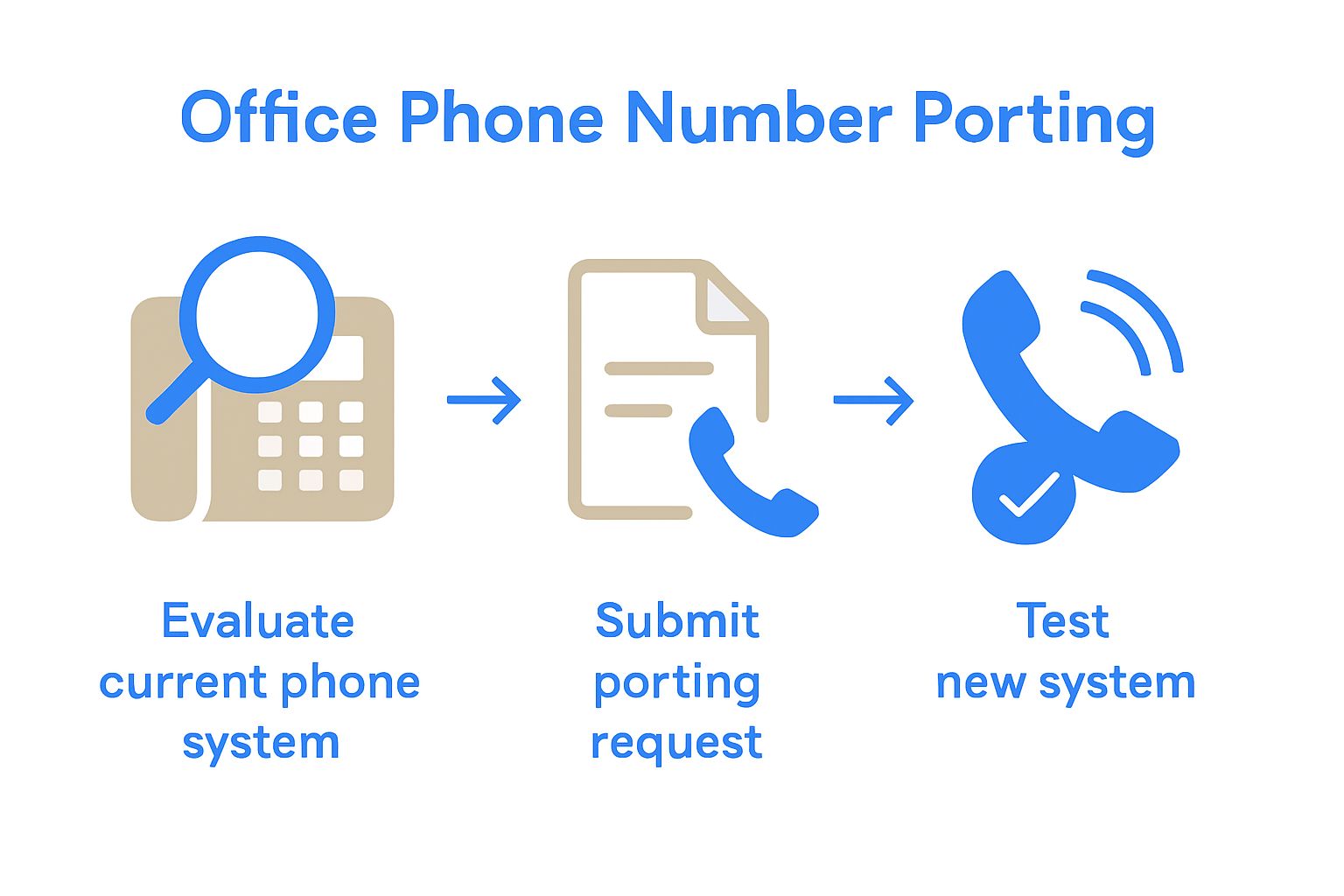Porting your office phone number can seem like a messy hassle. You might think switching providers is as easy as filling out a form and waiting for a confirmation. But the reality is far more complex and skipping key steps can mean service gaps, lost calls, or unexpected fees. Surprisingly, even your contract might have hidden porting restrictions that delay your entire transition. What catches most businesses off guard is that the real challenge starts before you ever submit a request. You can avoid those breakdowns with one smart move.
Table of Contents
- Step 1: Evaluate Your Current Phone System
- Step 2: Choose A New Service Provider
- Step 3: Gather Necessary Documentation
- Step 4: Initiate The Porting Request
- Step 5: Confirm Porting Completion And Test Functionality
Quick Summary
| Key Point | Explanation |
|---|---|
| 1. Evaluate Your Current Phone System | Conduct a thorough inventory of your existing phone lines, equipment, and contracts to identify potential porting challenges. |
| 2. Choose the Right Service Provider | Select a provider that matches your technical needs and offers reliable support for a successful number porting process. |
| 3. Gather Essential Documentation | Collect all necessary documents, including recent bills and authorization forms, to avoid delays during the porting process. |
| 4. Initiate the Porting Request | Officially request the port with your new provider, ensuring all details are accurate and documentation is in place. |
| 5. Test Functionality Post-Porting | After porting, conduct tests on all communication features to confirm they work properly and resolve any issues quickly. |
Step 1: Evaluate Your Current Phone System
Evaluating your current phone system is the critical first step in successfully porting your office phone number. This foundational assessment helps you understand your existing communication infrastructure and identify potential challenges before beginning the porting process.
Start by conducting a comprehensive inventory of your current phone lines, telecommunications equipment, and service contracts. Gather all relevant documentation, including your existing service agreement, recent phone bills, and hardware specifications. Pay close attention to your current provider’s contract terms, as some agreements might include early termination fees or specific porting restrictions that could impact your transition.
Explore our guide on cloud phone system implementation to understand how modern communication technologies can streamline this evaluation process. During your assessment, document key details about your current system:
- Total number of phone lines and extensions
- Current service provider and contract expiration date
- Types of phone hardware currently in use
- Existing calling features and integrations
Carefully review your business communication needs during this evaluation. Consider factors like call volume, remote work requirements, and potential future growth. Some businesses discover that their current system no longer supports their operational demands during this initial review. Look for signs that indicate it might be time for a system upgrade, such as frequent call drops, limited scalability, or high maintenance costs.
Technical compatibility is another crucial aspect of your system evaluation. Verify that your existing phone numbers can be technically ported to a new provider. Not all phone numbers transfer seamlessly, especially for specialized lines like fax numbers or toll-free services. Contact your potential new service provider to confirm the portability of your specific phone numbers and discuss any potential complications.
By thoroughly examining your current phone system, you’ll create a solid foundation for a smooth number porting process. This detailed assessment minimizes potential disruptions and ensures you have all necessary information prepared for the subsequent steps of your telecommunications transition.
Step 2: Choose a New Service Provider
Selecting the right service provider is a pivotal moment in your office phone number porting journey. This step requires careful consideration of multiple factors that go beyond simple pricing comparisons. Your new telecommunications partner will be critical to your business communication infrastructure, so approach this decision strategically.
Learn more about cloud phone system implementation to understand the broader context of modern communication solutions. When evaluating potential providers, develop a comprehensive assessment framework that examines their technical capabilities, service reliability, customer support, and alignment with your specific business needs.
Begin by researching providers that specialize in business telecommunications and have proven experience in number porting. Look for providers offering transparent pricing structures, robust feature sets, and demonstrated expertise in seamless number migration. Key evaluation criteria should include:
- Network reliability and uptime guarantees
- Technical support availability and responsiveness
- Compatibility with your existing communication tools
- Scalability for future business growth
Reach out directly to potential providers and request detailed information about their porting process. Prepare a list of specific questions that address your unique business requirements. Inquire about their exact porting procedures, potential downtime during transition, and any associated fees. Reputable providers will be transparent about potential challenges and offer clear guidance through the migration process.
According to Federal Communications Commission guidelines, confirm that your chosen provider can legally port your specific phone numbers. Some providers have geographic or technical limitations that might complicate number transfers. Request a comprehensive assessment of your number portability before committing to a new service.
Carefully review the proposed service contract, paying special attention to terms related to number porting, contract duration, and potential early termination conditions. Look beyond introductory pricing and evaluate the long-term value and support each provider offers. A slightly higher monthly cost might be justified by superior technical support, advanced features, or more flexible service terms.
Once you have narrowed down your options, request formal porting estimates and implementation timelines from your top candidates. Schedule consultations to discuss your specific business communication needs and verify that the provider can deliver a smooth, disruption-free transition. The goal is finding a partner who understands your operational requirements and can support your business communication strategy effectively.
Step 3: Gather Necessary Documentation
Gathering the necessary documentation is a critical step in the office phone number porting process that requires meticulous attention to detail. This stage will determine the smoothness of your telecommunications transition, making thorough preparation essential for avoiding potential delays or complications.
Learn more about setting up your business phone system to understand the broader context of telecommunications documentation. Begin by creating a comprehensive document collection strategy that ensures you have all required paperwork readily available. The most important documents you will need include recent phone bills, account authorization forms, and proof of business ownership.
According to Federal Communications Commission guidelines, your documentation must accurately represent your current telecommunications account. Collect the following critical documents:
- Current phone service provider bill (within last 30 days)
- Business registration documents
- Authorized user identification
- Current phone system hardware inventory
Your recent phone bill serves as the primary verification document for number porting. Ensure the bill clearly displays your business name, current phone number, account number, and billing address. If the account is under a different legal entity name or address, gather additional documentation explaining the connection. This might include business registration certificates, tax documents, or ownership transfer paperwork.
Authorization is another crucial aspect of documentation gathering. Verify that all individuals listed as account administrators are prepared to provide consent for the number porting process. This may require collecting signed authorization forms from each authorized user or business principal. Some providers might request additional identification verification, such as government-issued photo identification or corporate tax documents.
Pay special attention to any unique circumstances that could complicate your documentation. For businesses with multiple locations, complex ownership structures, or recently changed contact information, extra documentation might be necessary. Proactively communicating with your new service provider about your specific situation can help identify potential documentation challenges early in the process.
Organize your collected documents in a clear, digital folder with high-quality scans or clear photographs.
The following table provides a checklist of essential documents and information you should gather before initiating the number porting process to minimize delays and complications.
| Required Item | Purpose | Notes |
|---|---|---|
| Recent phone bill (within 30 days) | Verifies account and phone number details | Should display business name and address |
| Business registration documents | Proof of business ownership | Needed if legal entity differs |
| Authorized user identification | Confirms who can approve the port | Ensure all admins are available |
| Account authorization forms | Provides consent for number porting | May require signatures |
| Current hardware inventory | Confirms the equipment in use | Eases technical validation |
| Service contract | Reveals porting restrictions or fees | Review for hidden conditions |
Ensure all documents are legible, with no obscured text or poor image quality. Create backup copies and store them securely, both digitally and in a physical format. This comprehensive approach will streamline the porting process and demonstrate your business’s professionalism and preparedness.
Step 4: Initiate the Porting Request
Initiating the porting request marks the official beginning of your telecommunications transition. This critical step transforms your preparatory work into actionable progress, requiring precision and strategic communication with both your current and new service providers.
Explore our insights on switching carriers to understand the nuanced approach needed for a successful transfer. The porting request is more than a simple form submission – it represents a complex interaction between telecommunications networks that demands careful coordination.
According to Federal Communications Commission guidelines, your new service provider will typically manage the porting request process on your behalf. Schedule a dedicated consultation with your chosen provider to formally initiate the transfer. During this meeting, review all documentation and confirm every detail of your current account and desired transfer specifications.
Prepare to provide comprehensive information during the porting request:
- Exact phone numbers to be ported
- Current account holder’s legal name
- Current service provider details
- Billing address associated with existing account
- Authorized user contact information
Timing is a critical consideration in the porting request. Most providers recommend initiating the process during off-peak business hours to minimize potential service interruptions. Be prepared for a potential transition period that could range from 24 hours to several business days, depending on the complexity of your telecommunications setup.
Carefully review the proposed porting timeline and ask your new provider about potential contingency plans. Some businesses choose to maintain temporary overlapping service to ensure uninterrupted communication during the transfer. Discuss backup communication strategies with your team to mitigate any potential connectivity gaps.
After submitting the porting request, maintain open lines of communication with both your current and new service providers. Request written confirmation of the initiated port and establish clear points of contact for tracking the request’s progress. Some providers offer online portals or tracking systems that allow you to monitor the status of your number transfer in real-time.
Finalize the process by confirming all technical details with your new provider. Verify that they have received all necessary documentation and that your porting request has been officially submitted. Proactive communication and meticulous attention to detail will help ensure a smooth and efficient telecommunications transition.
Step 5: Confirm Porting Completion and Test Functionality
Confirming the completion of your phone number porting process is a crucial final step that ensures your business communications remain uninterrupted and fully functional. This verification stage goes beyond simple confirmation – it represents a comprehensive validation of your new telecommunications infrastructure.
Learn more about achieving a smooth porting process to understand the nuanced approach needed for thorough system validation. Immediate and systematic testing is essential to identify and resolve any potential connectivity or functionality issues that might have emerged during the transfer.
According to Federal Communications Commission guidelines, your comprehensive testing should cover multiple communication channels and scenarios. Develop a structured testing protocol that methodically examines every aspect of your newly ported phone system.
Conduct a comprehensive functionality test that includes:
- Inbound and outbound call testing from all business lines
- Verification of voicemail system and message retrieval
- Testing of fax and specialized communication lines
- Confirmation of caller ID and call forwarding features
Document each test meticulously, recording the time, specific line tested, and outcome. Begin by making test calls from both internal and external phone numbers, verifying that all previously configured features function correctly. Pay special attention to nuanced elements like call routing, automated attendant settings, and integrated communication tools.
Involve multiple team members in the testing process to ensure a comprehensive review. Different departments may utilize phone systems differently, so gathering diverse perspectives will help identify potential issues more effectively. Schedule a brief testing window during a low-traffic period, allowing sufficient time to address any unexpected challenges without disrupting critical business operations.
Reach out to your new service provider immediately if you encounter any irregularities during testing. Most providers offer dedicated support channels for recently ported numbers, with technical teams prepared to troubleshoot and resolve transition-related complications quickly.

Here is a troubleshooting table to help you quickly identify common issues that can occur during the phone number porting process, their typical causes, and suggested solutions based on the article.
| Problem | Common Cause | Suggested Solution |
|---|---|---|
| Unexpected service downtime | Incomplete documentation or timing issues | Maintain overlap service, check timing |
| Porting delays | Missing or inconsistent paperwork | Double-check details, clarify with provider |
| Number can’t be ported | Technical or geographic limitations | Verify portability with new provider |
| Lost calls after porting | Misconfigured call routing or setup | Retest system, contact provider support |
| Voicemail/features malfunction | Settings not transferred correctly | Systematic testing, adjust configurations |
| Early termination fees surprise | Overlooked contract terms | Review contracts before porting |
Ultimately, successful porting completion means more than just functional phone lines. It represents a strategic upgrade to your business communication infrastructure. Celebrate this milestone with your team, recognizing the careful planning and execution that made this seamless transition possible. Your proactive approach ensures continued operational excellence and robust communication capabilities.
Ready to End Porting Hassles? Switch to Seamless Business Communications
Struggling with outdated phone systems and worried about potential downtime or complex paperwork when porting your office number? The article walked you through every step—evaluating your current system, choosing a provider, handling compliance, and confirming successful porting. You do not need to feel uncertain or overwhelmed by the details any longer. Imagine your business running on a reliable, cost-effective, and modern cloud phone system with zero surprises and local support you can trust.
Take the next step with Voipcom. Our solutions eliminate hidden fees and complicated processes, so you can port your business phone number or overhaul your communications without disruption. We handle everything from porting to ongoing support, letting you focus on your business milestones instead of phone outages. Explore how switching to a fully managed cloud-based phone system can keep your business connected and prepared for the future.
Visit our home page now to schedule a free consultation or learn more about how Voipcom enables smooth, stress-free number porting for growing businesses like yours.
Frequently Asked Questions
What is the first step in the office phone number porting process?
Evaluating your current phone system is the first critical step. Begin by assessing your existing telecommunications infrastructure and gathering necessary documentation such as service agreements and recent phone bills.
How can I choose the right service provider for number porting?
Selecting a new service provider involves careful research and comparison of their capabilities. Focus on factors like technical support, reliability, and pricing, then reach out to confirm their number porting procedures and any associated fees.
What documentation do I need to gather for phone number porting?
You will need crucial documents, including recent phone bills, proof of business ownership, and any account authorization forms. Collect and organize these documents efficiently to streamline the porting request process.
How do I initiate the porting request with my new provider?
To initiate the porting request, consult with your new service provider to confirm the required information and documentation. Provide details such as the phone numbers to be ported and the current account holder’s legal name, ideally within your first meeting.
What steps should I take to confirm the completion of the porting process?
After submitting your porting request, confirm its completion by testing all functionalities of the new phone system. Conduct tests for inbound and outbound calls and other features, documenting your findings to ensure your communication setup is fully operational.
How long does the phone number porting process take?
The phone number porting process can range from 24 hours to several business days, depending on the complexity of your telecommunications setup. Aim to initiate the process during off-peak hours for the best chance of a smoother transition.




